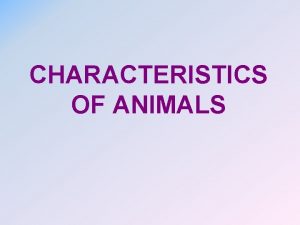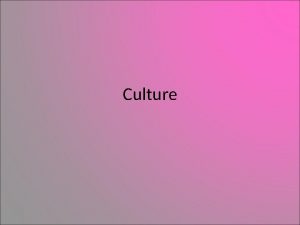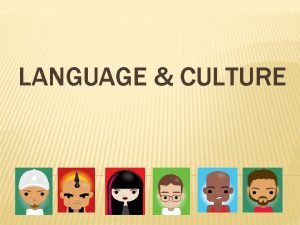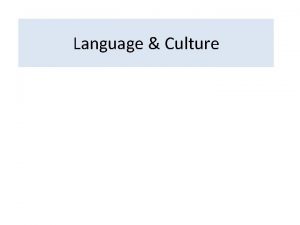Culture I Characteristics of Culture Language The method












- Slides: 12

Culture

I. Characteristics of Culture • Language – The method of human communication, either spoken or written, consisting of the use of words in a structured and conventional way.

Characteristics of Culture • Religion - The belief in and worship of a superhuman controlling power, esp. a personal God or gods

Characteristics of Culture • Architecture – the collective character or style of building:

Characteristics of Culture • Clothing – unique garments worn collectively as a people.

Characteristics of Culture • Food - any nourishing substance that is eaten, drunk, or otherwise taken into the body to sustain life, provide energy, promote growth collectively.

Characteristics of Culture • Government - the political direction and control exercised over the actions of the members, citizens, or inhabitants of communities, societies, and states; – Democratic Government – Totalitarian Government

Characteristics of Culture • Family Life – A set of norms that most a population follows at the family level of living. – Number of people who live in house – Responsibilities of each family members. – Who to marry – What is normal

Characteristics of Culture • Economics - the management of the resources of a community, country, etc. , especially with a view to its productivity. – Traditional – choices made by old customs – Market – buyers make the choices – Command – government makes choices – Mixed – blend of Market/Command • Most economies in the world are mixed includeing the United States.

II. Culture Traits • Traits are shared activities and behaviors of a people • utensils to eat with varies in cultures • traits are linked to – Islam - no pork no alcohol – Judaism – no pork wine allowed – Hog farms in the middle east? Israel yes because Judaism is the Religion • culture traits change through time • 1. Clothes – 40’s, 50’s, 60’s, 70’s, 80’s, Now • 2. The way we shop. 50’s Mom and Pop, Wal-Mart and ecommerce today • 3. Transportation

III. Cultural Hearths • An area with many shared cultural traits is called a Culture Region. • Theses regions can create many ideas and innovations. – Cultural Hearth – a region where important new ideas and innovations originate. • These ideas then travel to other cultures and they adopt that element for their own called diffusion. • Examples – Democracy invented in ___Greece____ – Wheel invented in ___Mesopotamia____ – Gunpowder invented in ___China_____ – Other examples Automobile, Factory system, i. Phone – Domestication of Wheat

IV. Cultural Conflict Traditional vs. Modern • Change that occurs within a culture • The counterculture of the 1960’s Nationalism • A feeling of pride in ones nation; We are better than you • Healthy for a country • However: Extreme example: Germany WW II Religion – • When people believe one religion is the correct religion • The Crusades • Al Qaeda Politics Natural Resources • Democratic vs. totalitarian – never in the history of man has two democratic nations ever go to war with each other • The Cold War( Vietnam, Korea) • The United Nations is designed to solve problems and reduce conflict • Finite number of resources in this world • Superpower colonize less developed nations, then conflict emerges over the land its resources; Japan attacked Pearl Harbor because of __OIL and Metal___?
 Symposium method
Symposium method Hát kết hợp bộ gõ cơ thể
Hát kết hợp bộ gõ cơ thể Ng-html
Ng-html Bổ thể
Bổ thể Tỉ lệ cơ thể trẻ em
Tỉ lệ cơ thể trẻ em Voi kéo gỗ như thế nào
Voi kéo gỗ như thế nào Chụp phim tư thế worms-breton
Chụp phim tư thế worms-breton Hát lên người ơi
Hát lên người ơi Các môn thể thao bắt đầu bằng tiếng đua
Các môn thể thao bắt đầu bằng tiếng đua Thế nào là hệ số cao nhất
Thế nào là hệ số cao nhất Các châu lục và đại dương trên thế giới
Các châu lục và đại dương trên thế giới Cong thức tính động năng
Cong thức tính động năng Trời xanh đây là của chúng ta thể thơ
Trời xanh đây là của chúng ta thể thơ























